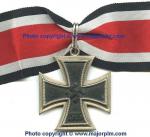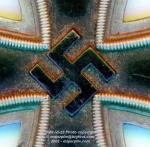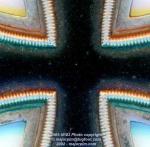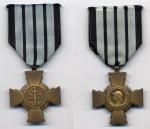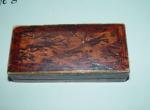-
Posts
2,284 -
Joined
-
Last visited
-
Days Won
6
Content Type
Profiles
Forums
Blogs
Gallery
Events
Store
Everything posted by PKeating
-

EK 1939 Help with Wiederholungsspange
PKeating replied to Tom Y's topic in Germany: All Eras: The Iron Cross
Of course, none of these 1st pattern Bars would have had an LDO code as they were quickly superseded by the revised 2nd type. PK -
Mind you, there were several variations produced by Junckers, as this zinc-cored cross with neusilber or nickle-silver frames shows. This cross predates the tightening of the rules pertaining to the production of the Ritterkreuz in March 1941, when, amongst other stipulations, the authorities forbade the use of anything other than iron and silver as materials. However, even though there has been some discussion about the centre or core, the frames are the deal-maker, struck on the same dies used for all RK by C E Juncker. However, as I said, go for a textbook classic in iron and silver, in decent condition, and you shan't have to 'defend' it if the day comes to sell it. The riband loop is of course in .800 silver. PK
-
There are some reliable dealers out there. However, if you wish to collect the Knight's Cross of the Iron Cross, or just add one to your collection, you ought to study the subject closely before parting with your money. A genuine LDO-marked C E Juncker cross would set you back around 6.5k in rough condition, unless you were lucky enough to find one for less. However, it might prove difficult to sell when the time came to upgrade so it is better to go that extra mile, so to speak, and pay the money for a nice one. There are a couple of good references out there. The books by Gordon Williamson and Dietrich Maerz come to mind, although there are a few caveats that have been much discussed on the various forums. The book by Previtera is also worth having although there are some howlers in it. However, Gordon Williamson's book is a very good 'primer' study as it covers the crosses produced by the authorised suppliers. It also covers other crosses and some variations but this is really territory, with all due respect, that you ought not to venture into just yet. As far as the genuine crosses are concerned, it is a good idea to stick with 'safe' examples, like those by C E Juncker and the Godet/Zimmermann partnership as the Juncker dies were very likely destroyed when the factory was bombed out in 1944 and there is no evidence that the dies used to produce the Godet and Zimmermann crosses, which are very rare, survived the war. Juncker is a very good choice and the frames are very distinctive. Study the cross-hatching in these two photos. It is a very good starting point, although there are other reference points to learn as well. Obviously, the same frame strikings were used for the obverse and reverse sides of the cross. Compare these to the cross you were considering. PK
-
Save your money. This is a well-known type of fake, probably made in Latvia about seven or eight years ago. The fakers tried to emulate the cross-hatching effect on the inner corners of the beading on original C E Juncker crosses but, like so many other details, got it wrong. This fake has also been seen with other makers' marks. PK
-
The 3rd Colonial Parachute Regiment badge is nice.
-
Never seen these before! Thank you for showing them. PK
-
Hallo and welcome! There are a few French and French-based collectors here who are very into US militaria and could doubtless help you to find French items in return for a similar service on your part. I've helped a few Americans with their wants list myself. So you have certainly landed in one of the better places on the web. But don't expect responses right away because August is vacation month in France and most people are on the beach! PK
-
-
Pause for thought. Turn towards Verdun. Raise beer and think of them all for a moment. P
-
The 17th Tank Battalion, Tank Corps, was formed in March 1918 and renamed 17th (Armoured Car) Tank Bn or 17th (AC) Tank Bn the following month as it was destined to convert to armoured cars. However, when the unit was posted to Dublin in January 1919 - having participated in the Battles of Amiens, Bapaume, 2nd Battle of Arras (2nd) and Cambrai - B Coy had Medium A Whippet tanks and C Coy had some Mk IVs, subsequently replaced by Mk Vs. So the tank pictured in Dublin and the one mentioned in connection with Limerick were from C Coy, 17th (AC) Tank Bn, Tank Corps. If you go to the Pathé website - http://www.britishpathe.com/record.php?id=77302 - you can see newsreel of the Limerick tank, sent there to assist with the handling of labour unrest and the suppression of the Limerick Soviet in April 1919. I've grabbed you a still, attached below, of the Limerick tank. Otherwise, the tanks were generally used in support of Army and DMP raids in Dublin, along with armoured cars, usually as mobile road blocks although they were also used as mobile cover by advancing infantry and to break down enemy roadblocks and other obstacles. Hope this helps. P
-
I am sure I recall seeing similar images in the distant past. I'll try and remember where. This looks a bit like Lower Mount Street. OK, I know there are more than a few streets with buildings of this style and architecture but it just seems to suggest Lower Mount Street. There was fighting in and around Lower and Upper Mount Street and around the bridges over the Grand Canal. PK
-
Here is another example struck by Arthus Bertrand with what appears to be a clasp by Mourgeon, the firm that also produced German Kriegsmarine badges during the Franco-German 'partnership' of 1940-1942. The certificate was issued in Saigon in 1947 to Sergent Roger Loncle of the French Air Force's Compagnie de Garde de l'Air 595. The C.G.A 595 was tasked with securing Tan Son Nhut airport, near Saigon, after the Japanese surrender in August 1946. French armed forces had co-existed uneasily with the Japanese armed forces during their occupation of Indo-China and there would have been a contingent of French guards stationed at Tan Son Nhut, which was familiar to many American service personnel some twenty years later. This unit might previously have been the Compagnie de Police Sécurité at Tan Son Nhut. Some sources say that the C.P.S. Tan Son Nhut was redesignated C.G.A 595bis, then C.G.A 595 and, later, C.G.A 31/191. I am inclined to believe that C.G.A 595 was the unit designation of the 150-strong contingent airlifted to Tan Son Nhut in August 1945 and that these men were drawn from Free French Forces in Europe. This might explain the presence of the FRANCE clasp on Loncle's War Medal. The ENGAGÉ VOLONTAIRE clasp also points to a Frenchman who volunteered to join General de Gaulle's forces rather than staying in France. However, perhaps there are some members here who can tell me more than I have so far been able to find out. The document is signed by General Raoul Salan, Commander-in-Chief of French forces in Indo-China in the early stages of the First Indo-China War. Salan would later gain notoriety for his rôle in, amongst other things, the attempted coup d'état against President de Gaulle in 1961. The rebels took control of Algiers and other major centres but the putsch des généraux, as it is also known, was suppressed before they could carry out their planned airborne assault on central Paris. Apparently, the rebel command planned a parachute drop on the Tuileries gardens, as insane an idea as Otto Skorzeny's plan for SS-Fallschirmjäger-Btl 500 to jump on Budapest during the 1944 German-sponsored coup d'état. Along with others, Salan was charged with treason and condemned to death in absentia. On the run, he and others founded the OAS or Organisation de l'Armée Secrète, best-known to those unfamiliar with postwar French history through the opening scenes of Day of the Jackal, when OAS men spray de Gaulle's Citroën DS with machinegun fire. Salan was captured in 1962 but his sentence was commuted to life imprisonment. He and other officers were amnestied in 1968 and released. In 1982, their ranks and honours were restored in a move by the socialist Mitterand government that enraged many of France's committed lefties. However, Mitterand himself had a chequered past, as a former calgoulard and one of the relatively few Vichy officials awarded the Ordre de la Francisque by Pétain before he reinvented himself as a Résistance hero. French politics and history are nothing if not complicated... On second thoughts, Timo, why not just keep the medal and clasp. PK
-
It is definitely a Chobillon striking. However, Chobillon does not appear to have produced the EXTREME ORIENT clasp although the general appearance of this clasp evokes Chobillion products. Like other examples I have seen or added to my collection, this clasp was probably made locally, hence the orthographic oversights like the missing hyphen and circumflex. The EXTRÊME-ORIENT clasp was instituted on 5.8.1946 and was similar to the clasp instituted for the 1939-1945 War Medal. It was specifically for personnel who had fought against the Japanese between 9.3.1945 and 10.9.1945 or against "the rebels" - the forerunners of the Viet Minh - from 23.9.1945 onwards. On 19.7.1948, eligibility was extended to civilians. The area of operations covered Indo-China and other French possessions like Cambodia and Laos. Interestingly, it does not seem to have been extended to French forces that fought against the Thais in 1940 and 1941. These combatants had received the INDOCHINE clasp instituted by the Vichy government on 19.9.1941. This clasp was outlawed by the vengeful Gaullists on 7.1.1944. However, this injustice was actually rectified by a governmental decree on 2.2.1949, which republished the Vichy decree of 19.9.1941 verbatim, thereby allowing veterans of the 1940-1941 conflict between France and Thailand to wear their INDOCHINE clasps, though not on the "État Français" versions of the Colonial Medal! It's a nice example of this combination. They're not terribly rare but as Vétéran says, they are a classic mainstay of any Médaille Coloniale collection and I think the €25,00 paid by our colleague Timo was money very well spent. As a Dubliner, though long-since expatriated, I am pleasantly surprised to hear that an Irish medal dealer didn't try to charge two or three times the normal asking price. You should offer it in the For Sale section here. I've seen these selling in France and on French eBay for around €40,00, which is a reasonable price so you stand to make some beer money out of this, Timo! PK
-
Very typical, I'm afraid. Pay peanuts, get monkeys. Of course, they're always hyper-efficient when billing you, or pulling a bait and switch stroke. PK
-
My mistake, Monkey. Posted the same pic twice. As you can see, no markings. There is what appears to be the indentation from pinstriping about 8 cm in from the edges, around the raised part of the lid, probably gold leaf at one point but long gone.
-
-
This example came from a family. The construction and external pattern are fairly typical of the mid to late 19th century. The lid is silk-padded and I suspect that there may be a part missing from the interior of the base. However, the medal is mint and the box is in extremely good condition and I believe that this is the sort of box in which it was supplied by retail outlets. Such boxes may have served for other medals too, such as the campaign medals of the period, although I have never seen another like it. PK
-
It is quite scarce, Chris. Well-spotted. From Wikipedia: The Free French column of some 500 men was commanded by Leclerc and comprised native troops from Chad, Senegal and the camel-mounted Groupe nomade de Tibesti, supported by elements of the British Long Range Desert Group and bombers flown by Free French aircrew. Libya was part of the Italian Empire and General de Gaulle took the view that were the British expelled from Egypt by the Afrika Korps, which looked possible in 1941, Chad would be vital in terms of defending French colonial interests in Africa. After taking the fort and oasis at Koufra (I posted the extremely rare London-made medal and clasp earlier) in March 1941, elements of Leclerc's column began harassing Italian forces around Murzuk in February 1942. The following December, Leclerc sent in a force of 3,250 men in 1,000 vehicles with twelve aircraft providing air cover to take Murzuk, which they did on 12.1.1943. The column then took Mizda on 22.1.1943 before entering Tripoli in 26.1.1943, having covered 2,575 kilometres of desert since rolling across the border from Chad into Libya. Leclerc's force was taken onto British 8th Army strength as "L-Force" for the rest of the North African war. The medal itself is a classic Paris mint striking in silver, the hallmark postdating 1913. The Afrique Occidentale Française clasp was instituted in 1901 and awarded up to 1936 for service and various operations in French Equatorial Africa. It was also awarded by the Vichy government from November 1940 for operations in connection with the defence of Dakar between September 23 and 26 1940. However, this clasp bears the hallmark of Albert MARIE Ingénieur, a firm that started life, according to Hass, as A. D. MARIE and ended up as Louis AUBERT, at 14 rue Oberkampf, which is about eight minutes from our Paris flat. So, I would say that the medal and the AOF clasp may date from the late 1920s to the early 1930s. The Tunisie clasp was instituted in 1894 and this example seems to be a Marius Delande striking. Free France did not issue a Tunisie clasp. The Free French version was 'Tunisie 1942-1943', instituted on 7.1.1944, but the wearer of this medal may have acquired a Tunisie clasp from a retail outlet. Plenty of French soldiers took little liberties with their campaign medals. The Madagascar clasp is an Arthus Bertrand product. Instituted on 26.3.1942, the Fezzan clasp was made by various manufacturers and this one is hard to identify. However, it relates specifically to the operations in February and March 1942, which places the wearer in Leclerc's original column and at Murzuk. Who was he? A native soldier who served in Tunisia during WW1, putting down insurrections, operations for which the clasp was revived in 1919? A man who then served with one of the great expeditions of the interwar years, earning the AOF clasp, before marching into Libya with Leclerc in 1942 to earn his Fezzan clasp. Or did he earn the AOF clasp at Dakar in 1940 and later end up under Free French command, serving with Leclerc and then, after the war, in Madagascar in 1947? This is why it is important to drum it into the minds of the house-clearers and disinterested descendants flogging this stuff off to market traders or on eBay that they must look for and recover the frigging paperwork! Even it drives up the prices of these ensembles. I look at this medal and wish I knew the history of the man who wore it, a career covering several possibilities, each one just as fascinating as the last. There again, if African, maybe the papers served to roll a few cigarettes as the veteran sat watching the setting sun, listening to goat bells and his wives bickering as they made him tea and coucous... And who could blame him for that? PK
-
-
Textbook. Looks to be period as well. Or, at least, closer to the period than most of the crosses offered by dealers, which are sourced from French wholesalers today. Perfectly genuine, to all intents and purposes, except those of collectors. PK
-
Not in France. But I suppose anything can be found easily enough at the SOS and MAX shows.
-
I'd like to add to Frank's expression of appreciation for sharing the box with us. Amazing! I have only seen two award certificates in thirty-odd years but had not seen the box until now. There are bound to be all kinds of variations on the medal itself from full through half to miniature size. I have seen them the size of a little fingernail for mounting on lapel chains right up to full size, with differences indicating different makers. I have one in a period box which may have been the one in which it was supplied by a retail outlet at some point. I'll photograph it and post it later, when I have a moment. But yours is without any doubt the official box in which the first series of medals for award to veterans came. Magnificent! PK


